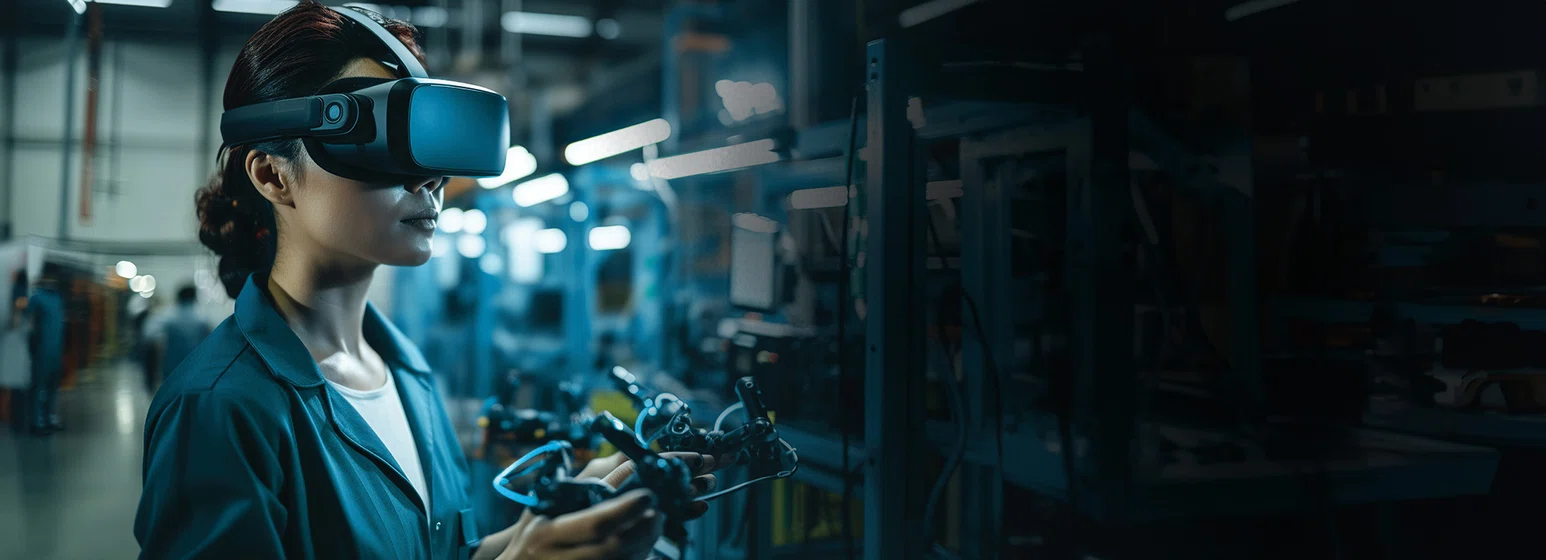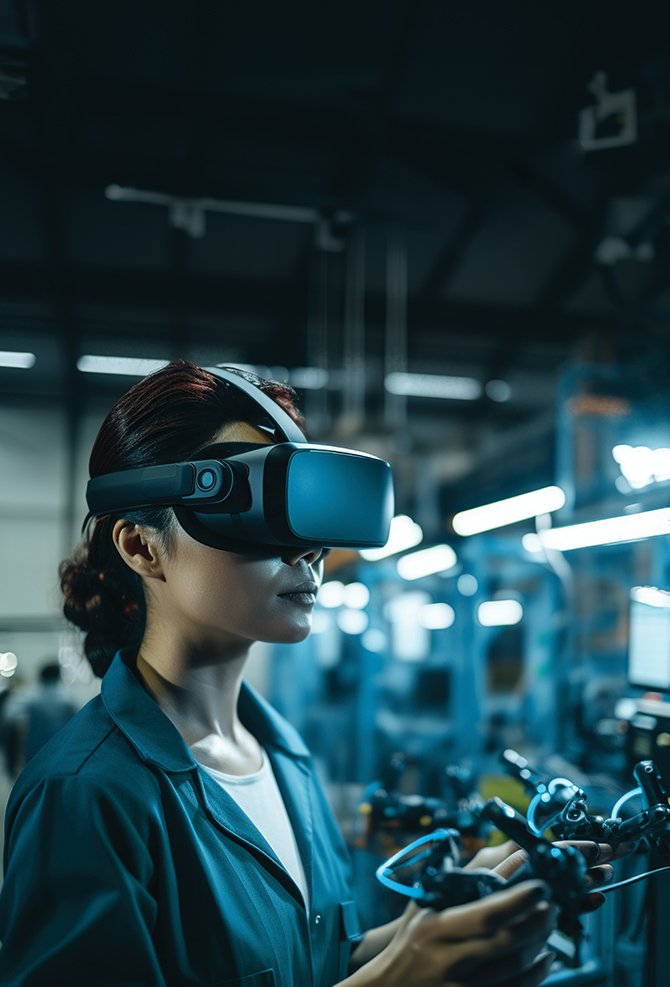


Follow us on:
CONTACT US | Download the 2021/2022 issue | ©Atlas Copco AB
result
Search
A MAGAZINE FROM ATLAS COPCO GROUP
Sustainable technologies
Markets
Smart manufacturing
Our culture
Service and Consulting
Energy efficiency


An exciting
new reality
Extended Reality (XR) technologies hold great promise for Atlas Copco Group’s products and processes. XR Group leader Wes Tomer and some pioneering colleagues explain how this helps customers and colleagues.
They once belonged to the realms of computer games and science fiction, but Extended Reality technologies such as Augmented Reality (AR) and Virtual Reality (VR) are transforming industrial processes and products.
Atlas Copco is already on-board, with XR projects underway in all corners of our business (see four case studies below) and an XR Group that involves 150 people across all four Business Areas.
“XR offers a powerful and versatile way of interacting with 3D models of our products, to explore them and to enable collaboration between experts and those who are learning,” explains Wes Tomer, Extended Reality Program Manager for Semiconductor divisions in Vacuum Technique. Wes is educating people about the technology and how it can add business value to Atlas Copco and our customers.
AR and VR are well suited to our digitalized workplaces. Augmented Reality overlays 3D digital holograms of products within the user’s real-world context, while Virtual Reality immerses the user in the 3D environment. Among other things, this means interactive training on complex tools and processes, and quicker, more convenient ways to meet people virtually and solve product users’ problems.
“A technician can go through a full product disassembly and service procedures in VR without many of the traditional challenges. Travel is not required, and there’s no risk of damaging the machine, losing parts or hurting the customer’s process because the entire procedure is virtual,” says Wes.
While they can’t replicate the unique advantages of face-to-face training and servicing, XR technologies are good for Atlas Copco’s multinational business and customer base. Wes Tomer is working on several initiatives around 3D product models within the Vacuum Technique Business Area, and planning a proof of concept with VR software with use-cases from each of the four business areas.
“XR is making significant advances towards a more human and natural interaction with the digital world. I want to see our colleagues and customers embrace the possibilities and benefits this brings,” he says.

A technician can go through a full product disassembly and service procedures in VR without many of the traditional challenges. Travel is not required, and there’s no risk of damaging the machine, losing parts or hurting the customer’s process because the entire procedure is virtual.”
Wes Tomer
Extended Reality Program Manager for Semiconductor divisions in Vacuum Technique

How Atlas Copco is exploring XR
Power Technique: Parham Naderi
For the past two years, Business Process Expert Parham Naderi has been leading a project that uses AR and VR to make product design review quicker and more cost-effective.
Atlas Copco’s design reviewers are responsible for improving a product’s quality, performance and functionality, and reducing the risk of issues during product development. That can be lengthy and costly, as design reviewers may have to travel long distance to the Atlas Copco site where the product is located to make the assessment.
This project is testing Microsoft HoloLens Augmented Reality ‘smart glasses’. When combined with a tailormade software they enable a ‘collaboration meeting’ in a virtual room. Design reviewers and engineers can look at the machine together, so the reviewers can advise the engineers remotely on what needs realigning or changing.
“By simply using the HoloLens and watching the machine in front of us it reduces a lot of effort and site travel,” says Parham. “This way we could save money and reduce carbon emissions.”
The project is still at proof-of-concept stage with testing in Belgium and India, but Parham hopes its initial promise will lead to the next step by the end of 2023.
“I’m excited about the potential,” he says.
Vacuum Technique: Richard Swayne
Semiconductor fabrication plants can be risky places for our field service engineers because they work in the sub-fabs, where chemical byproducts of silicon wafer manufacturing are abated and made safe.
There’s a strict safety regime, but training for that environment is difficult. Traditional PowerPoint modules don’t provide hands-on experience, while building replica integrated exhaust management systems to transport around the world for training would be too costly and impractical.
Richard Swayne, Head of Learning and Development for Semiconductor and Semi-Service Divisions, and his colleague, Ondrej Hrudka, have developed a pilot training software that creates a virtual sub-fab. Trainees wearing a Virtual Reality headset navigate a safe, virtual space, familiarizing themselves with sub-fab hazards and safety controls, including immersive shower, first aid kit and emergency telephone.
“It’s a way of enabling them to feel like they’re actually in a sub-fab and for things to be happening around them without the risk of harming them physically,” Richard explains. “They navigate round the space and then there’s a final module where they carry out a typical task of collecting a pump and moving it, with all the hazards in play.
“It’s intense, but it’s an important and practical complement to an instructor’s role. Ideally, you wouldn’t want a trainee learning in a live, high-risk environment, so let them have that first training in the virtual world before putting them into the real world.”
The concept is being trialed in South Korea and the US, and Richard hopes initial positive results will lead to wider adoption.

Industrial Technique: Nicolo’ Fioretti
Anyone who’s struggled to build home furniture will recognize the frustration of following the instructions.
It’s even more challenging for our field service engineers, who consult manuals for complex, high-quality products featuring advanced mechanical, electronic and software technology. Sometimes a technician needs assistance from specialist colleagues, so the customer has to wait days or weeks for a solution.
This motivated Nicolo’ Fioretti, a Milan-based Competence Team Manager in the Industrial Technique Business Area, to work with Atlas Copco design technology partner PTC to develop an augmented reality experience based on the computer-aided design (CAD) drawings of the STBench.
“Our field service engineers can access the CAD through an app on their smartphones. They see our animated, 3D-representation of the product in front of them, with step-by-step instructions on what to do. It’s like having a trainer in your pocket!”
Nicolo’s team has also used AR to enhance customers’ user experience. He’s created a QR code for the STRwrench leaflet. Customers use the code to download an app with a 3D-preview of the product functionality before buying it, or when they have a product and need guidance.
“As with the 3D animations, we’re using AR to make the learning process simpler, saving time for our customers. It can give both field service engineers and customers a real confidence boost.”
Nicolo’s team is already planning more AR and VR applications.

Compressor Technique: Simone Rabadozza

In Montecchio Maggiore, Vicenza, Italy, Atlas Copco Group company Ceccato Aria Compressa partnered with researchers from the University of Padua to create a simulation of a new manufacturing procedure before it moved into a new, larger factory.
Ceccato Aria Compressa assembles compressors and produces integrated dryers, as well as making filtration cartridges for compressed air. It’s one of the largest-volume production sites in the whole Group, and some of the units it makes are then assembled by some of our other companies. The knock-on effect of a production stop doesn’t bear thinking about!
“We wanted to make a lot of changes to the production flows for the new plant, so we could gain flexibility, capacity and safety,” explains Simone Rabadozza, Manufacturing Manager with responsibility for the site and the man who led the project.
“We were looking for a way to simulate the new plant, the new flows and the new operations - especially the logistics - to see where the bottlenecks would be and where the constraints were, and to troubleshoot potential issues before actually physically building the facility and designing the workflow.
“The university had VR tools that allowed us to create a complete digital twin of the factory based on the real data – the output, flows, speeds…everything. Once we decided the marker scenario we were able to put all the data in and see where the issues were popping up: where the lines were too fast or too slow, if the reception was good or not, and so on.”
Ceccato Aria Compressa moved into the new factory in 2022, and the successful simulation helped ensure a smooth transition to continued high-intensity production.
Suggested Articles



